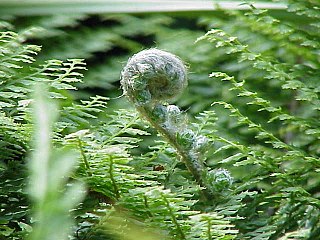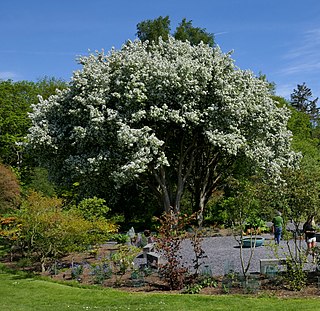
Botrychium is a genus of ferns, seedless vascular plants in the family Ophioglossaceae. Botrychium species are known as moonworts. They are small, with fleshy roots, and reproduce by spores shed into the air. One part of the leaf, the trophophore, is sterile and fernlike; the other, the sporophore, is fertile and carries the clusters of sporangia or spore cases. Some species only occasionally emerge above ground and gain most of their nourishment from an association with mycorrhizal fungi.

Sceptridium is a genus of seedless vascular plants in the family Ophioglossaceae, closely allied to the genus Botrychium. It is also closely related to the genus Botrypus. Sceptridium species are commonly called the grape-ferns.

Polystichum is a genus of ferns in the family Dryopteridaceae, subfamily Dryopteridoideae, according to the Pteridophyte Phylogeny Group classification of 2016. The genus has about 500 species and has a cosmopolitan distribution. The highest diversity is in eastern Asia, with about 208 species in China alone; the region from Mexico to Brazil has at least 100 additional species; Africa, North America, and Europe have much lower diversity. Polystichum species are terrestrial or rock-dwelling ferns of warm-temperate and montane-tropical regions. They are often found in disturbed habitats such as road cuts, talus slopes, and stream banks.

Viola canadensis is a flowering plant in the Violaceae family. It is commonly known as Canadian white violet, Canada violet, tall white violet, or white violet. It is widespread across much of Canada and the United States, from Alaska to Newfoundland, south as far as Georgia and Arizona. It is a perennial herb and the Latin-specific epithet canadensis means of Canada.
Phyllostachys heteroclada, the fishscale bamboo, also known as "water bamboo", is a running bamboo. The water bamboo name comes from the air canals in the rhizomes and roots that allow this bamboo to grow in more saturated conditions as compared to similar species. This species can also have abrupt kinks at the base of the culms. Maximum height can reach 35 ft with a diameter of 2 in. It is cold hardy to around -5 °F. It grows well in USDA zones 6b-10.
Hecistopteris is a fern genus in the Vittarioideae subfamily of the Pteridaceae.

Malus hupehensis, common names Chinese crab apple, Hupeh crab or tea crabapple, is a species of flowering plant in the apple genus Malus of the family Rosaceae.

Physocarpus opulifolius, known as common ninebark, Eastern ninebark, Atlantic ninebark, or simply ninebark, is a species of flowering plant in the rose family Rosaceae, native to eastern North America, named for its peeling multi-hued bark

Psilostrophe, the paperflowers is a genus of North American plants in the sneezeweed tribe within the sunflower family.

Subularia is a genus of plants in the family Brassicaceae. Subularia species are annual herbs that grow in moist or even flooded soils. There are only two species of the genus: Subularia aquatica, which is widespread in North America and Europe; and Subularia monticola, from Africa mountains. Awlwort is a common name for plants in this genus.

Campyloneurum angustifolium is a fern species in the family Polypodiaceae, commonly known as narrow strapfern or narrow-leaf strap fern.

Oreochrysum is a genus of flowering plants in the family Asteraceae.

Poa secunda is a widespread species of perennial bunchgrass native to North and South America. It is highly resistant to drought conditions, and provides excellent fodder; and has also been used in controlling soil erosion, and as revegetator, often after forest fires. Cultivars include 'Canbar', 'Service', 'Sherman', and 'Supernova'. Historically, indigenous Americans, such as the Gosiute of Utah, have used P. secunda for food. It was originally described botanically in 1830 by Jan Svatopluk Presl, from a holotype collected from Chile by Thaddäus Haenke in 1790.

Rhododendron minus var. minus, the Carolina azalea or Carolina rhododendron, is a rhododendron species native to the mountains of North Carolina, South Carolina, Tennessee, and Northeast Georgia. It is commonly known as Rhododendron carolinianum in the horticultural trade.

Oenothera albicaulis is a New World plant in the evening primrose family. It is known by the common names prairie evening-primrose, white-stem evening-primrose, whitish evening primrose, or whitest evening primrose.
Schoenoplectus etuberculatus, common name Canby's bulrush, is a plant species native to the United States. It is reported from every state on the Gulf and Atlantic coasts from eastern Texas to Delaware, plus isolated populations in Rhode Island and Missouri. It is an emergent plant growing in ponds, marshes, stream banks, etc., including in brackish water along the coast.














